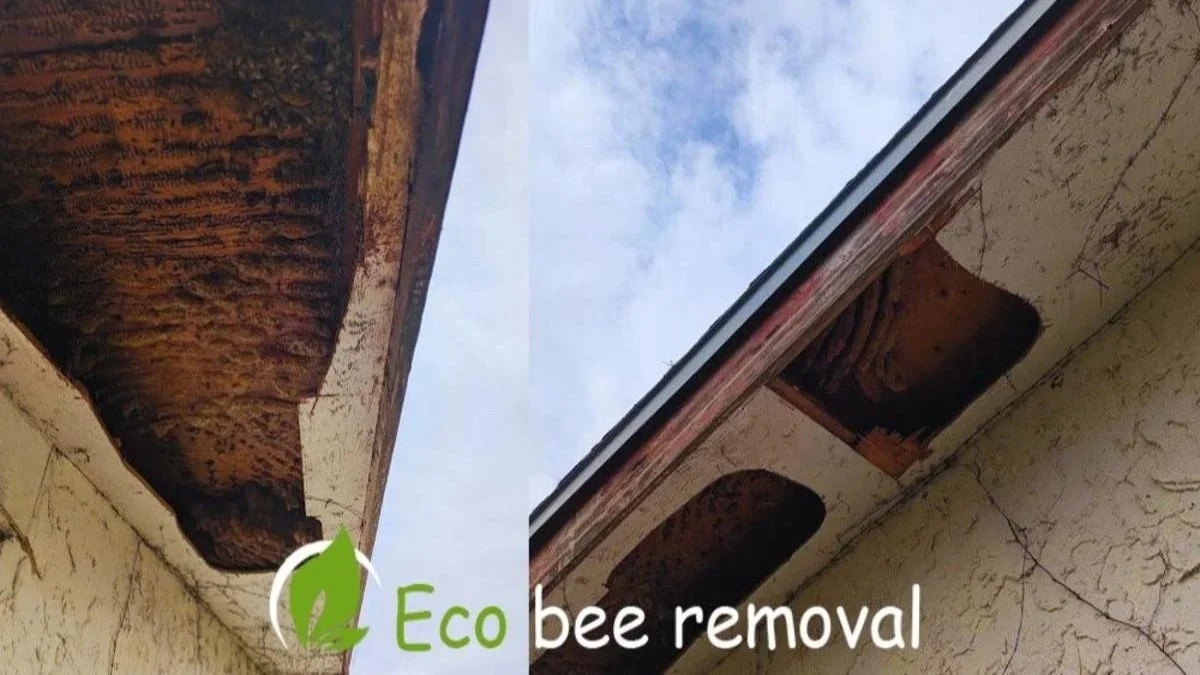How Soffit & Roof Rafters Let Bee Hives Grow Unchecked.
When homeowners plan a remodel, bees are usually the last thing on their minds. But in Florida and other warm regions, honeybees often turn hidden parts of a home’s structure—like soffits, roof rafters, and eaves—into massive colonies that can quietly expand for years. What starts as a small swarm can turn into a full-scale hive weighing over 100 pounds, filled with honey, wax, and thousands of bees.
Understanding how certain building features make homes perfect for bees—and how to handle the problem during a remodel—is crucial for protecting both your property and the bees themselves.
Hidden Dangers of a Hive Inside a Home
Why Bees Choose Soffits and Roof Rafters
Bees prefer dark, enclosed spaces that stay warm and dry. In modern homes, the soffit and roof rafter structures create exactly that type of environment.
Soffits are the underside areas of a roof that connect the exterior walls to the roof’s edge. When these are vented or damaged, bees can enter through small gaps. Once inside, the space between the soffit and roof rafters becomes a perfect cavity for building a comb.
Here’s why bees love it:
Shelter from weather: The structure keeps out rain and direct sunlight.
Stable temperature: Rafters help maintain warmth, ideal for brood rearing.
Low disturbance: Homeowners rarely check these areas.
Ample space: Bees can expand their hive between rafters, growing without limits.
Over time, a hive can extend across multiple rafters or spread from the soffit into attic insulation, creating a serious removal challenge.
How Remodeling Reveals Hidden Bee Hives
Many homeowners first discover a hive during remodeling projects—especially when workers remove siding, repair roofing, or open soffits. Suddenly, decades of hidden bee activity come into view: layers of comb, dripping honey, and thousands of worker bees defending their home.
Contractors often describe the sight as “a living wall.” What looked like a small hole from the outside can reveal:
Extensive comb structures spanning several rafters
Multiple colonies in different roof sections
Honey dripping into insulation or drywall
Structural wood darkened by wax and propolis
If the bees are disturbed without proper handling, they may become aggressive, or worse, relocate deeper into the structure.
The Hidden Dangers of a Hive Inside a Home
A hidden bee colony doesn’t just mean buzzing and honey. Over time, it can cause serious damage to your home.
Hidden Dangers of a Hive Inside a Home
Honey seepage: When honey melts from attic heat, it can seep into walls or ceilings, staining drywall and attracting ants, roaches, and rodents.
Structural weakening: The constant moisture and bee traffic can damage insulation, wood framing, and electrical wiring.
Odor and mold: Decomposing wax or honey can produce strong odors and mold growth.
Secondary infestations: Once bees are removed, leftover comb attracts wax moths and beetles that cause further contamination.
For these reasons, proper live bee removal and cleanup are essential—not just killing or spraying the colony.
Bee Removal During a Remodel: What Professionals Do
If bees are discovered during a remodel, stopping construction and calling an eco-friendly bee removal specialist is the safest course of action. Here’s how professionals handle it:
Inspection: Using thermal imaging or sound detection, experts locate the hive’s exact boundaries.
Access creation: The soffit or rafter section is carefully opened without damaging the structure more than necessary.
Live removal: Bees are gently vacuumed into a portable hive box using a low-suction bee vac system.
Comb extraction: All honeycomb, brood, and wax are removed to prevent reinfestation.
Cleanup & repair: The cavity is cleaned with an eco-safe solution, dried, and sealed.
Relocation: Bees are safely relocated to local apiaries where they continue pollination work.
This method not only protects your home but also supports local bee populations—an essential step in environmental conservation.
How Construction Design Enables “Unlimited Growth
Bees’ instincts drive them to expand their colonies when space allows. In a home’s soffit or rafter system, that space can seem endless.
Here’s how it happens:
Rafter cavities can extend several feet along the roofline, giving bees a long corridor to expand their comb horizontally.
Double soffit layers or vented channels act like connected chambers, encouraging vertical hive growth.
Unsealed joints or fascia boards allow for air circulation—helping bees regulate internal hive temperature.
Without disturbance, a hive can grow undetected for years, expanding through interconnected rafters and even into the attic or wall voids.
Eco-Friendly Bee Removal: Why It Matters
Eco-Friendly Bee Removal in Florida
At Eco Bee Removal, we believe in saving bees, not exterminating them. Honeybees are vital pollinators, responsible for much of our food supply. Spraying pesticides or sealing hives only causes long-term damage—to both your home and the environment.
Instead, live bee relocation ensures:
Bees survive and continue pollination.
Your home remains safe and honey-free.
The local ecosystem stays balanced.
By choosing eco-friendly removal, you’re not only protecting your home—you’re helping protect Florida’s pollinator population.
Preventing Future Infestations After Remodeling
Once bees are removed and the remodel resumes, prevention is key. Here’s how homeowners can bee-proof their property:
Seal all soffit vents and roof gaps with fine mesh or caulk.
Inspect fascia boards and roof edges annually for rot or gaps.
Use bee-resistant materials like treated wood or aluminum vent covers.
Avoid leaving sweet smells or open compost near construction areas.
Schedule annual inspections during spring and early summer—prime swarm season.
Preventative maintenance after a remodel ensures bees don’t return to the same inviting cavity.
Real Florida Example: Bees Behind the Soffit Board
In one recent Florida remodel, a contractor discovered bees behind a soffit board that had a small, weathered crack. Upon inspection, our team found an 8-foot-long hive stretching along the rafters—housing nearly 50,000 bees.
The hive had been expanding for at least three years. Honey had melted into insulation, and the rafters were darkened with propolis. Our eco-friendly team safely relocated the bees and removed over 60 pounds of comb. The homeowner then installed aluminum soffit panels and sealed all entry gaps.
This case shows how easily bees can thrive unseen—and how proper removal can restore both the structure and environmental balance.
Final Thoughts
When remodeling a home, discovering bees in soffit or roof rafter structures can be surprising—but it’s also an opportunity to help nature. Bees choose these areas because they provide everything they need for unlimited growth: protection, warmth, and space.
By choosing live bee removal and eco-friendly repair, homeowners can preserve their investment, prevent damage, and support pollinator health.
If you suspect bees in your roof or attic, don’t seal the hole or spray chemicals. Call Eco Bee Removal at (888) 282-1886 for safe, professional, and environmentally responsible bee relocation across Florida.



